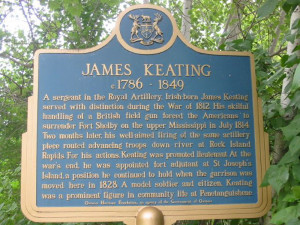James Keating was born in the parish of Templeshort, county of Wexford, Ireland in 1786. His father was murdered when James was in his teens which likely prompted him to join the Royal Regiment of Artillery at the age of 18 in 1804.
He received a medal for his good service at Martinique and eventually made his way to the Canadas for the War of 1812.

A sergeant in the Royal Artillery, Irish-born James Keating served with distinction during the War of 1812. His skillful handling of a British field gun forced the Americans to surrender Fort Shelby on the upper Mississippi river in July 1814. Two months later, his well-aimed firing of the same artillery piece routed advancing troops down-river at Rock Island Rapids.
That action is described more fully as follows:
“In the summer of 1814 the United States decided to do something about the perceived British threat at Prairie du Chien and to secure the upper Mississippi river for the United States. In June, American soldiers from St. Louis arrived at Prairie du Chien. Commandeering land, they erected a fort on a mound situated behind the village. The fort, named Fort Shelby, for Kentucky Governor Isaac Shelby, was garrisoned by 60 United States troops and their officers, with additional protection provided by the gunboat, “Governor Clark”, anchored in the Mississippi to the west of the fort. Upon the arrival of the United States troops, many of the residents, especially traders, left Prairie du Chien and traveled to Fort Michilimackinac asking the British commander for assistance.

“William McKay, a trader, was commissioned a Lieutenant Colonel and authorized to form and lead a military expedition to Prairie du Chien. Three prominent traders, Joseph Rolette, Thomas Anderson, and Pierre Grignon, were commissioned captains of companies of volunteers to be drawn from the ranks of voyageurs.
“One British regular was attached to the force. Sergeant James Keating, of the : was to man the brass three-pound field cannon allocated to the expedition. A small company of Michigan Fencibles was placed under McKay’s authority. Robert Dickson, British Indian Agent, attached part of his Indian force to the expedition consisting of three bands of Dakota and about one hundred Winnebago with a few Mesquakie. To keep the Indians under control, officers of the Indian Department, including Michael Brisbois, Jr., of Prairie du Chien, accompanied the group. At Green Bay, Menominee and Ojibwa joined. By the time they reached the Mississippi river just below Prairie du Chien McKay estimated his force at 650 men.
“The force arrived in Prairie du Chien on Sunday July 17. Positioning the companies around the prairie, about noon, terms of surrender were presented to Lieutenant Joseph Perkins, commander of United States troops in the fort. Upon refusal, fighting commenced with an attack on the gunboat. By late in the day, the Governor Clark was forced to cut her lines because of the accuracy of the three-pound gun manned by Keating. Drifting away from Prairie du Chien, Fort Shelby was left without provisions and ammunition.
“The battle continued for two or more days with the Indians growing restless and McKay positioning his troops closer to the fort. Finally the British-Canadians decided to end the stalemate and began to prepare hot shot for the three-pounder to set the wooden fort afire. Confronted with diminishing ammunition, no provisions, a lack of water, and potential fire, the Americans presented a flag of truce. Terms of surrender were negotiated. The morning of July 20, Lt. Perkins and the troops marched out of the fort and laid down their arms. The men were paroled and arrangements were made to send the Americans back to St. Louis. It had been a bloodless affair but secured British control of the entire upper Mississippi valley. To insure the territory remained British, a fort was to be maintained in Prairie du Chien. Fort Shelby was invested with British forces from Mackinac and renamed Fort McKay.
“Keating’s skillful handling of the 3 pound gun prompted him to become known as “one gun Keating” a nickname that endured through his lifetime.
“In 1815 he was promoted to Lieutenant and was made fort adjutant at St. Joseph’s Island, then to Drummond Island until it was returned to the United States in 1828.
“Keating moved the garrison to Penetanguishene and attained the rank of Captain and adjutant, which he held until his death in 1849 at the age of 63.”
Captain James Keating was instrumental in petitioning the crown to build a church to service the spiritual needs of his garrison, and was successful in obtaining the land and funds to built St. James-on-the-Lines Anglican Church, an historic jewel still in use today.
A model soldier and citizen, Keating was a prominent figure in community life at Penetanguishene. He raised his family in Penetanguishene and was very active in the community.
The cemetery at St. James-on-the-Lines is his final resting place.
Veteran Summary
James KeatingCaptain, Royal Artillery
Place of Birth
Parish of Templeshort, County of Wexford, Ireland
Place of Death
Penetanguishene, ON, CAN
Died on: 01 JAN 1849
Reason: Natural causes at the age of 63
Location of Grave
St. James-on-the-Lines Anglican cemetery, Church Street
Penetanguishene, ON, CAN
Latitude: 44.78945N Longitude: -79.926924

